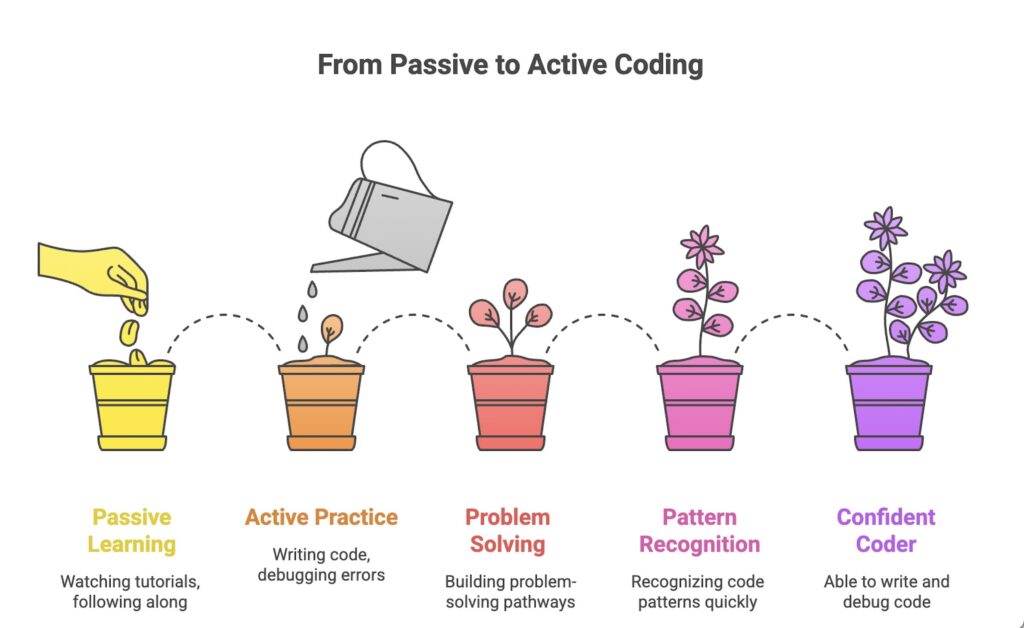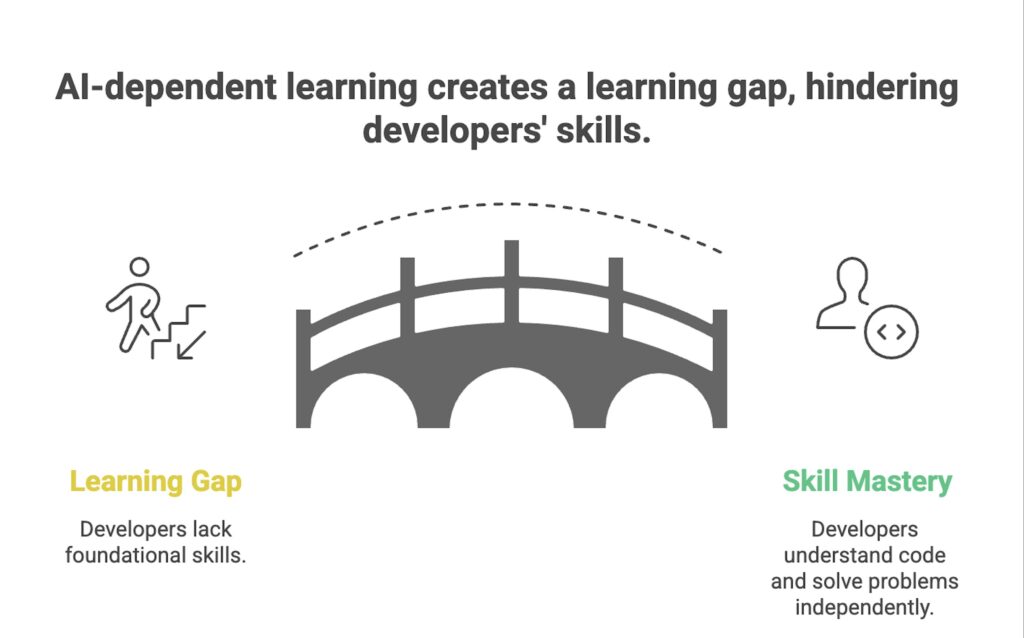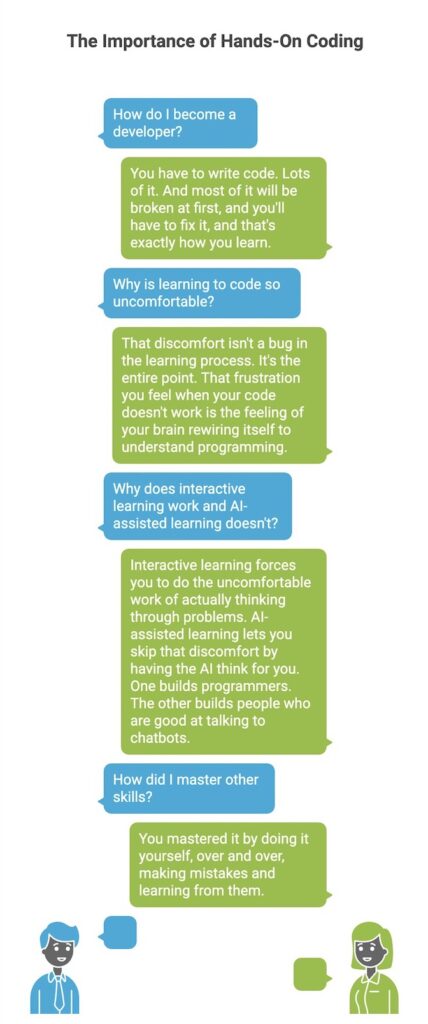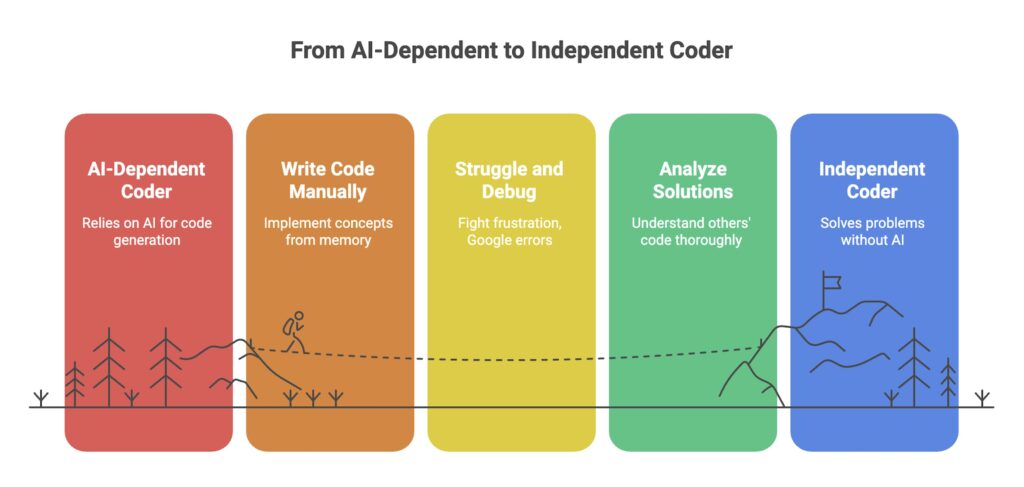Why Beginners Can’t Learn to Code Using AI

“Just tell ChatGPT what you want and it’ll write the code for you.”
This is the promise of what developers are now calling “vibe coding.” Describe your app in plain English, let the AI generate all the code, and boom, you’re a programmer. No need to understand syntax, data structures, or how any of it actually works. Just keep prompting until something appears to work.
It sounds like magic. And for people who’ve struggled to learn programming the traditional way, it sounds like the solution they’ve been waiting for. Why spend months learning to code when AI can do it in minutes?
Here’s the problem: you’re not actually learning to code. You’re learning to prompt an AI. And when that AI-generated code inevitably breaks, or when you need to build something the AI can’t quite understand, or when you sit down for a technical interview, you’ll discover you never learned how to program at all.
The research on this is starting to come in, and it’s not pretty. AI coding assistants are creating a generation of people who can generate code but can’t understand, debug, or maintain it. And for beginners trying to break into tech, this might be the worst possible way to learn.
The Data on AI-Assisted Learning Is Damning
Let’s start with accuracy. A Purdue University study found that ChatGPT’s code solutions were incorrect 52% of the time. Think about that. You’d be better off flipping a coin than trusting the AI’s first attempt at solving a coding problem.
But it gets worse. Even when the AI produces code that appears to work, there are hidden problems. Research analyzing AI-generated code found that up to 40% of queries are vulnerable to SQL injection attacks. AI assistants frequently implement security checks on the client side instead of the server, creating massive vulnerabilities that beginner developers don’t even know to look for.
And here’s the kicker: 67% of developers report spending more time fixing AI-generated code than they would have spent writing it themselves. The tool that’s supposed to make you faster actually makes you slower, because you’re constantly debugging code you don’t understand.
The security and accuracy issues are bad enough. But the real problem is what happens to learning itself.
Multiple studies on students using AI coding tools have found the same disturbing pattern: students can complete programming assignments with AI assistance, but when tested on similar problems without AI, they can’t solve them independently. The AI did the thinking for them. They never developed the foundational problem-solving skills that separate someone who can program from someone who can only prompt.
One study put it bluntly: “Over-reliance on AI tools hinders foundational learning, especially for beginners.” Another found that students using AI tools showed reduced engagement in key self-regulated learning processes like reflection and self-evaluation, leading to what researchers called “metacognitive laziness.”
Translation: using AI to learn coding makes you dependent on AI instead of teaching you to think like a programmer.
Why Writing Code Yourself Actually Works
At Algocademy, we see this play out in our completion data. We offer 17 free lessons where people can dabble, watch, and follow along more passively. Only 6% of people who start these lessons finish all 17. It’s the same dismal completion rate you see across free coding courses everywhere.
But when students commit to our paid interactive courses where they have to write every single line of code themselves, 43.7% complete the full 150-lesson fundamentals course. That’s not a small bump. That’s seven times more likely to finish. And it’s not because paying customers are more motivated, though that helps. It’s because the method actually works.
Research backs this up across the board. A meta-study analyzing 57 different studies on learning found that hands-on learners performed 20% better than students who learned with only auditory lectures. But the difference is even more dramatic when you look at retention. Traditional lecture formats result in only 8% to 10% knowledge retention. Interactive learning approaches can achieve retention rates as high as 60%.
That’s the difference between recognizing code when you see it and actually being able to write it yourself.
Here’s what happens in your brain when you write code yourself that doesn’t happen when AI writes it for you: You build problem-solving pathways. Every time you get stuck and work through a problem, you’re strengthening the neural connections that help you solve similar problems in the future. Watching AI solve a problem, or even watching a human solve a problem in a tutorial, doesn’t create these pathways. Only doing it yourself does.
You learn to debug. The most important skill in programming isn’t writing perfect code on the first try. Nobody does that. The real skill is looking at broken code, understanding what went wrong, and fixing it. You can’t learn this by having AI generate code for you. You can only learn it by writing code that breaks and fixing it yourself, over and over, until debugging becomes second nature.
You develop pattern recognition through repetition. When you’ve personally written a for loop fifty times, your fingers know how to type it. Your brain recognizes when you need one. This embodied knowledge only comes from practice, not from prompting an AI to generate loops for you.
Most importantly, you build confidence. Every problem you solve yourself proves you can do this. Every time you have AI solve a problem for you, you prove only that you’re good at prompting. One builds developers. The other builds prompt engineers who can’t code.

The Learning Gap Creates Real Consequences
This isn’t just theoretical. The consequences of AI-dependent learning are already showing up in the real world.
Developers are reporting that they can build features with AI assistance but struggle when they need to understand the codebase well enough to modify it later. They hit walls when debugging because they never learned to read error messages or trace through code logic. They fail technical interviews because they can’t solve coding problems without AI holding their hand.
One particularly telling example: someone built an entire application using AI code generation tools, then realized they couldn’t maintain or update it themselves. When the AI-generated code broke, they were completely helpless. They’d built something impressive but had no idea how it worked.
This is what researchers mean when they talk about the “learning gap.” You can complete tasks with AI. You look productive. Your code runs. But you haven’t actually learned the underlying skills. And the moment you’re in a situation where you can’t use AI, or the AI produces something broken, or you need to understand code well enough to modify it significantly, you’re stuck.
It’s like using a calculator for every single math problem from first grade through high school and then being surprised when you can’t do mental math or understand mathematical concepts. The tool did the work. You never built the foundational understanding.

What Real Learning Requires
There’s no shortcut to becoming a developer. You can’t watch your way there through tutorials. You can’t prompt your way there through AI. You have to write code. Lots of it. And most of it will be broken at first, and you’ll have to fix it, and that’s exactly how you learn.
Real learning is uncomfortable. You get stuck. You spend 20 minutes tracking down a missing semicolon. You rewrite the same function three times before it works. You Google the same error message five times before you understand what it’s telling you.
That discomfort isn’t a bug in the learning process. It’s the entire point. That frustration you feel when your code doesn’t work is the feeling of your brain rewiring itself to understand programming. Every problem you solve yourself makes you stronger. Every solution you copy or generate with AI makes you weaker.
This is why interactive learning works and AI-assisted learning doesn’t. Interactive learning forces you to do the uncomfortable work of actually thinking through problems. AI-assisted learning lets you skip that discomfort by having the AI think for you. One builds programmers. The other builds people who are good at talking to chatbots.
Think about any skill you’ve actually mastered in your life. Maybe it’s playing an instrument, speaking a language, cooking, playing a sport, whatever. Did you master it by watching someone else do it? Or by having a tool do it for you? Or did you master it by doing it yourself, over and over, making mistakes and learning from them?
Programming is no different. Surgeons don’t learn surgery by watching AI perform operations. Pilots don’t learn to fly by letting autopilot do everything. And programmers don’t learn programming by letting AI write their code.

The Path Forward
AI coding assistants aren’t going away, and they shouldn’t. They’re incredibly useful tools for experienced developers who understand what the AI is doing and can verify its output. But for beginners, they’re a trap. They create the illusion of learning while preventing actual skill development.
If you’re serious about learning to code, here’s what you need to do: Write every line of code yourself, at least in the beginning. Fight through the frustration of not understanding something. Get stuck. Google things. Read error messages. Debug your own mistakes. Build the problem-solving muscles that separate developers who can actually code from people who can only prompt AI.
Use tutorials and documentation to understand concepts, but then close them and try to implement those concepts yourself from memory. If you get stuck, resist the urge to immediately ask AI for the answer. Sit with the problem. Think through it. Try different approaches. That struggle is where learning happens.
Only after you’ve tried to solve something yourself should you look at how others solved it, whether that’s human-written code or AI-generated solutions. And when you do look, make sure you understand every line. If you can’t explain why the code works, you don’t understand it well enough to use it.
This is harder than vibe coding. It takes longer. It’s more frustrating. But here’s the thing: it actually works. The completion data proves it. The research proves it. And most importantly, the developers who learned this way prove it every day when they can actually build, maintain, and debug real applications without AI holding their hand.
At Algocademy, we built our entire platform around this principle. Every lesson requires you to write code yourself. Not read code. Not watch code being written. Not prompt an AI to write it. You have to think through the logic, type it out, debug your mistakes, and understand why it works. It’s harder than other approaches, but 43.7% of our students finish 150 lessons because the method actually teaches them to code.
You can’t vibe code your way to being a real developer. But you can learn, line by line, problem by problem, mistake by mistake, until programming clicks. And when it does, you’ll have a skill that no AI can take away from you, because you built it yourself.
That’s the difference between generating code and understanding it. Between looking like a programmer and being one. Between depending on AI and knowing how to solve problems yourself.
Choose the hard path. It’s the only one that leads where you want to go.


